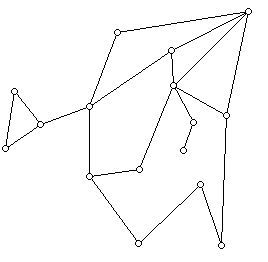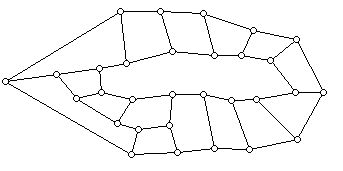
Review For Final Examination (Spring 2008)
Geometric Structures
Prepared by:
Joseph Malkevitch
Department of Mathematics
York College (CUNY)
Jamaica, New York 11451
email:
malkevitch@york.cuny.edu
web page:
http://york.cuny.edu/~malk/
1. Draw a diagram of the following (when possible the diagram should be drawn in the plane):
a. A scalene right triangle
b. An equiangular triangle
c. An equiangular 4-gon that is not a square
d. An equilateral quadrilateral that is not a square
e. A non-convex, non-self-intersecting 4-gon
f. A trapezoid with three equal sides that is not a rectangle
g. An equiangular hexagon which is not a regular hexagon
h. A self-intersecting regular octagon
i. An isosceles right triangle
j. An acute angle triangle
k. A parallelogram which is not a rectangle or a rhombus
l. A rhombus which is not a square
m. A quadrilateral with exactly two, nonadjacent right angles
n. Draw a graph with 10 vertices and 14 edges
o. Draw a 4-valent plane graph with two pentagons, 10 triangles.
p. Draw an isosceles triangle which is not equilateral
q. A non-convex self-intersecting 7 sided polygon
r. A convex plane quadrilateral which corresponds to the side length partition {1, 1, 1, 1 } and angle measure partition {2, 1, 1}.
s. A convex plane quadrilateral which corresponds to the side length partition {2, 1, 1 } and angle measure partition {2, 1, 1}.
t. What is the difference between a ray and a segment?
u. Draw graph which is planar but not plane.
v. Draw a graph which is non-planar.
w. A self-intersecting regular pentagon.
2. Give a precise statement of the graph theory version of Euler's formula, and be able to give a proof of this theorem.
3. Draw two graphs to which one can not apply Euler's formula, each for a different reason.
4. a. Write the pi values for the faces of the graph below.

b. Is there a pair of vertices u and v in the graph above such that there are three independent paths between these vertices?
c. Is the graph above 3-connected?
d. Write the vi values for the vertices of the graph above.
e. Color the vertices of the graph above with as few colors as possible.
f. Color the faces of the graph above with as few colors as possible.
5. Draw an example of a 3-valent (e.g. every vertex is 3-valent) graph which is 3-polytopal.
6. Draw an example of a 4-valent graph (e.g. every vertex is 4-valent) which is 3-polytopal.
7. Draw a plane graph with every vertex having valence at least 3 which is not 3-polytopal.
8. Give a statement of the four color theorem (face version).
9. (a) Can one color the faces of the graph in graph below with exactly 3 colors?
(b) What is the vertex chromatic number for the graph below?

13. Briefly describe models for: affine geometry, projective geometry, and hyperbolic geometry in each of the finite and infinite situations.
14. The situations below concern the relation between the Euclidean and real-projective planes.
a. What projective points correspond (if any) to the Euclidean points: (-2, -4); (0, 3); (9, 0)?
b. What Euclidean points correspond (if any) to the real projective points:
(-1, -2, 4); (0, 2, 1); (0, -5, 0); (2, -5, 4); (-2, 0, 0).
c. Find the line that goes through (0, 3, 0) and (-2, 4, 2) in the real projective plane?
d. Find the line through goes through (-2, 4) and (2, 6) in the Euclidean plane.
e. Find the point if there is one where the lines 2x - 3y + 2 = 0 meets -x + 2y + 8 = 0 in the Euclidean plane.
f. Find the point where 2x - y + z = 0 and -x - y + 4z = 0 meet in the real projective plane.
g. Draw a diagram to illustrate Desargues Theorem in the real projective plane.
h. Write down the equation of a line through (0, 2, 0) which passes through the point (-1, 2, 3).
i. Draw a diagram of the Fano plane.
j. If a finite affine plane is coordinatized with numbers from GF(5):
i. How many points will the geometry have? ii. How many lines will the geometry have? iii. How many points will be on every line? iv. How many lines will pass through every point? v. Write down the lines that go through (2, 3) (remember these numbers are from GF(5)). vi. Write down all of the points on 2x -3y = 4 vii. List all of the points on the projective extension to 2x-3y = 4.
15. (a) Draw a taxicab circle centered at (-5, 2) and radius 4.
(c) Determine the set of points which are equidistant from from (-10,2) and (6, 4) in the taxicab plane. (Describe the points using one or more equations.)
16. How many edges are needed for the optimal eulerization of the graph in Problem 4? (Be able to find an Eulerian circuit in a graph and know the characterization theorem for Eulerian circuits.